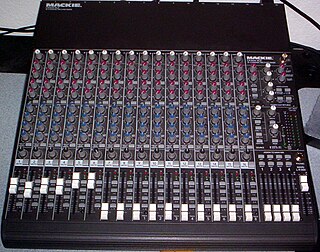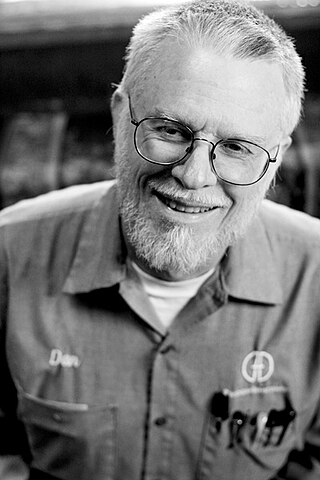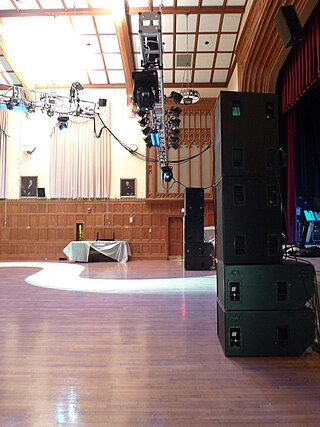Related Research Articles

A mixing console or mixing desk is an electronic device for mixing audio signals, used in sound recording and reproduction and sound reinforcement systems. Inputs to the console include microphones, signals from electric or electronic instruments, or recorded sounds. Mixers may control analog or digital signals. The modified signals are summed to produce the combined output signals, which can then be broadcast, amplified through a sound reinforcement system or recorded.
Solid State Logic (SSL) is a British company based in Begbroke, Oxfordshire, England that designs and markets audio mixing consoles, signal processors, and other audio technologies for the post-production, video production, broadcast, sound reinforcement and music recording industries. SSL employs over 160 people worldwide and has regional offices in Los Angeles, Milan, New York City, Paris, and Tokyo, with additional support provided by an international network of distributors. Solid State Logic is part of the Audiotonix Group.

Mackie is an American professional audio products brand. Founded in Seattle in 1988 by Greg Mackie as a manufacturer of affordable and versatile compact pro audio mixers, Mackie is the primary product line of LOUD Technologies.
Midas is a company that designs professional audio consoles. Founded in London in 1970 by Jeff Byers and Charles Brooke, today the company is part of the Music Tribe group of brands.

Rudolph Thomas Bozak (1910–1982) was an audio electronics and acoustics designer and engineer in the field of sound reproduction. His parents were Bohemian Czech immigrants; Rudy was born in Uniontown, Pennsylvania. Bozak studied at Milwaukee School of Engineering; in 1981, the school awarded him an honorary doctorate in engineering. Bozak married Lillian Gilleski; the two had three daughters: Lillian, Mary and Barbara.

Professional audio, abbreviated as pro audio, refers to both an activity and a category of high-quality, studio-grade audio equipment. Typically it encompasses sound recording, sound reinforcement system setup and audio mixing, and studio music production by trained sound engineers, audio engineers, record producers, and audio technicians who work in live event support and recording using mixing consoles, recording equipment and sound reinforcement systems. Professional audio is differentiated from consumer- or home-oriented audio, which are typically geared toward listening in a non-commercial environment.
LOUD Audio, LLC is a professional audio company based in the United States, operating in the U.S., Canada, and Shenzhen, China. Originally founded as Mackie Designs, Inc., the name was changed to Loud Technologies Inc in 2003 to differentiate its founding subsidiary, mixing console manufacturer Mackie from its eponymous brand name.

In professional audio, a digital mixing console (DMC) is a type of mixing console used to combine, route, and change the dynamics, equalization and other properties of multiple audio input signals, using digital signal processing rather than analog circuitry. The digital audio samples, which is the internal representation of the analog inputs, are summed to what is known as a master channel to produce a combined output. A professional digital mixing console is a dedicated desk or control surface produced exclusively for the task and is typically more robust in terms of user control, processing power and quality of audio effects. However, a computer can also perform the same function since it can mimic its interface, input and output.
Soundcraft is a British designer and importer of mixing consoles and other professional audio equipment. It is a subsidiary of Harman International Industries, which is owned by South Korean company Samsung Electronics. It was founded by sound engineer Phil Dudderidge and electronics designer Graham Blyth in 1973.

Arthur Rupert Neve was a British-American electronics engineer and entrepreneur, who was a pioneering designer of professional audio recording equipment. He designed analog recording and audio mixing equipment that was sought after by professional musicians and recording technicians. Some of his customers were music groups The Beatles, Aerosmith and Nirvana, and recording studios Sound City Studios and Abbey Road Studios. Companies that he was associated with included Neve Electronics, Focusrite, AMS Neve, and Rupert Neve Designs.
Yamaha Pro Audio, Inc. is a division of the Yamaha Corporation that offers a complete line of beginner professional audio products for the live sound and sound reinforcement markets. It has a long history of introducing significant products for the professional audio market such as the PM-1000 modular mixing console, the REV1 and SPX90 digital signal processors, the NS-10 studio monitors, and the 01v, 02R, 03D, PM1D, PM5D, QL5, M7CL, CL5, and PM10/7 Rivage digital mixing consoles.

An audio engineer helps to produce a recording or a live performance, balancing and adjusting sound sources using equalization, dynamics processing and audio effects, mixing, reproduction, and reinforcement of sound. Audio engineers work on the "technical aspect of recording—the placing of microphones, pre-amp knobs, the setting of levels. The physical recording of any project is done by an engineer... the nuts and bolts."

Smaart is a suite of audio and acoustical measurements and instrumentation software tools introduced in 1996 by JBL's professional audio division. It is designed to help the live sound engineer optimize sound reinforcement systems before public performance and actively monitor acoustical parameters in real time while an audio system is in use. Most earlier analysis systems required specific test signals sent through the sound system, ones that would be unpleasant for the audience to hear. Smaart is a source-independent analyzer and therefore will work effectively with a variety of test signals including speech or music.
Philip Stephen Dudderidge is a British sound engineering entrepreneur. He is a notable figure in the professional audio industry, having worked as Led Zeppelin's concert sound mixer, and later co-founding Soundcraft Electronics Ltd before serving as Chairman of Focusrite Audio Engineering Ltd.

Bruce Robert Jackson was an Australian audio engineer who co-founded JANDS, an Australian audio, lighting and staging company. He joined American touring audio engineer Roy Clair and mixed concert stage monitors for Elvis Presley in the 1970s. With Clair Brothers, a concert sound company, Jackson designed audio electronics including a custom mixing console. Beginning in 1978, Jackson toured as Bruce Springsteen's band engineer for a decade, using Clair Brothers sound systems. A business interest in Fairlight CMI in Sydney introduced Jackson to digital audio, and he subsequently founded the digital audio company Apogee Electronics in Santa Monica, California, where he lived at the time. After selling his share of Apogee, Jackson co-founded with Roy and Gene Clair a joint venture which produced the Clair iO, a loudspeaker management system for control of complex concert sound systems. Jackson turned the venture commercial with the help of Dave McGrath's Lake Technology. Dolby Laboratories bought the technology and formed Dolby Lake with Jackson as vice president, then in 2009 Lab.gruppen acquired the brand. Jackson was honoured with the Parnelli Innovator Award in 2005 for his inventive loudspeaker controller.

Dan Dugan is an American audio engineer, inventor, and nature sounds recordist. He was the first person in regional theatre to be called a sound designer, and he developed the first effective automatic microphone mixer: the automixer. Dugan's sound design work was acknowledged in 2003 with a Distinguished Career Award by the United States Institute for Theatre Technology, and in 2020 with an Emmy Award for technology relevant to remote working. In 2021 he was awarded Fellowship in the Audio Engineering Society.
Peter Watts is a designer of pro audio equipment who is recognized as a leader in his field.

A professional audio store is a retail business that sells, and in many cases rents, sound reinforcement system equipment and PA system components used in music concerts, live shows, dance parties and speaking events. This equipment typically includes microphones, power amplifiers, electronic effects units, speaker enclosures, monitor speakers, subwoofers and audio consoles (mixers). Some professional audio stores also sell sound recording equipment, DJ equipment, lighting equipment used in nightclubs and concerts and video equipment used in events, such as video projectors and screens. Some professional audio stores rent "backline" equipment used in rock and pop shows, such as stage pianos and bass amplifiers. While professional audio stores typically focus on selling new merchandise, some stores also sell used equipment, which is often the equipment that the company has previously rented out for shows and events.

Robert Vernon Cavin is an American audio engineer who built the first monitor mixing console, the first multi-angle monitor loudspeaker, and the first integrated processing/amplifier package for a 3-way loudspeaker. He was chief engineer of McCune Sound in San Francisco in the 1970s, and also vice president in the 1980s. In 1992 he accepted the chief engineer position at Apogee Sound where he designed the DA Series Class-H digitally controlled amplifier, winning the 1994 TCI Product of the Year Award. In 2000 he joined Furman Sound, and designed an interface system for Smaart users, and a new power conditioning system. Cavin's electronic designs were nominated five times for TEC Awards, in 1994, 1995, 1997, 1999 and 2001.
Malinda Lowe, is a Sri Lankan record producer, audio engineer, songwriter, and event manager particularly in Live Sound and mixing console. He is known for recording and mixing songs and synthesizers for major artists such as Shreya Goshal, Udit Narayan, Olivia Newton-John, Mohombi, Akon, Sonu Nigam, Bathiya and Santhush and The Gypsies. He is also the creator and founder of Universal Sound Productions.
References
- 1 2 3 4 "Soundcraft Founder Graham Blyth To Perform 32nd Concert Recital for the AES". News story. Soundcraft.com. 21 May 2010. Retrieved 7 December 2010.
- 1 2 3 4 5 6 7 "A Sound Craftsman". Systems Contractor News. 11 December 2007. Archived from the original on 8 January 2011.
- 1 2 3 4 5 6 7 8 9 10 "Soundcraft's Graham Blyth receives Fellowship Award". MusiciansNews.com. Archived from the original on 3 September 2012. Retrieved 7 December 2010.
- 1 2 3 4 5 6 "Graham Blyth FRSA (BSc Electrical Engineering 1969)". Alumni and friends. University of Bristol. October 2008. Archived from the original on 6 May 2009. Retrieved 8 December 2010.
- 1 2 3 4 "AES New York 2007 Awards Ceremony". 123rd AES Convention. Audio Engineering Society. 5 October 2007. Retrieved 8 December 2010.
- 1 2 3 4 5 "Graham Blyth: still smiling at 60". Pro Sound News Europe. 1 July 2008.
- 1 2 3 White, Paul (February 1995). "Graham Blyth: Designing Spirit Mixers". Sound on Sound. Cambridge, UK.
- 1 2 3 4 Shuler, Chris (June 2004). "Thirty Years of Crafting Sound: Soundcraft embarks on its fourth decade" (PDF). Live Sound International: 28–29. Archived from the original (PDF) on 26 July 2011. Retrieved 8 December 2010.
- ↑ Fred Goodman, "Keeping It All in Focus," Pro Sound News, Nov 2010, p. 74
- 1 2 Dudderidge, Phil. "Mini Autobiography of the Focusrite Chairman". A Word From Our chairman. Focusrite.com. Archived from the original on 30 July 2010. Retrieved 7 December 2010.
- ↑ Gilbert, Jerry (November 2009). "Roger Lindsay". TPI Magazine. Archived from the original on 15 December 2009.
- ↑ "New Products and Services". Billboard. Vol. 103, no. 41. Nielsen Business Media. 12 October 1991. p. 45. ISSN 0006-2510.
- ↑ Electronic Musician. Polyphony. 13 (1–6): 103. 1997.
{{cite journal}}: Missing or empty|title=(help) - ↑ Brown, Andy; Graham Blyth (January 2003). "It's a Dual Purpose World: Sussing out the Soundcraft MH4". Designer Notebook. Live Sound International. Archived from the original on 26 July 2011. Retrieved 8 December 2010.
- ↑ "Soundcraft Launches Three Mixer Ranges With Built-in Lexicon Effects". LiveDesign. Penton Media. 19 June 2007.
- ↑ Oliver, Brian (23 October 1982). "U.K. Firms Jumping on Digital Recording Bandwagon". Billboard. Vol. 94, no. 42. Nielsen Business Media. p. 47. ISSN 0006-2510.
- ↑ "Mix guides: Soundcraft". Mix magazine online. Penton Media. 15 April 2005. Archived from the original on 17 February 2006. Retrieved 8 December 2010.
- ↑ "Soundcraft Co-Founder Graham Blyth Receives Honorary Doctor of Science Degree from University of Hertfordshire". Soundcraft. 27 November 2012. Retrieved 9 February 2013.
- 1 2 Kolling, Niels (September 2008). "The John Leckie Interview". Sound on Sound. Retrieved 8 December 2010.
- ↑ "Rinky Dink & The Crystal Set – Cameo Roles". discogs.com. Retrieved 8 December 2010.
- ↑ "Rinky Dink and the Crystal Set – Discography". 45cat.com. Retrieved 8 December 2010.
- 1 2 "About Graham Blyth". Sounds. Veritas Organ Company. Retrieved 8 December 2010.
- 1 2 "Organ Concert in Saint Patrick's Cathedral". 111th AES Convention. Audio Engineering Society. Retrieved 8 December 2010.
- ↑ "Challow Park Recital Room". Projects. Multiload Technology. Retrieved 8 December 2010.
- ↑ "Wantage Chamber Concerts". Archived from the original on 12 September 2011. Retrieved 8 December 2010.
